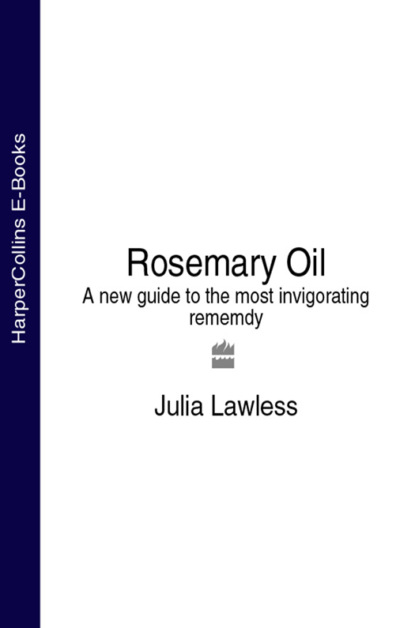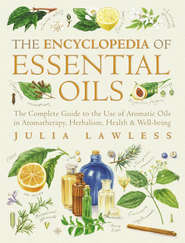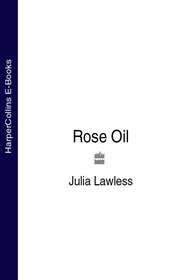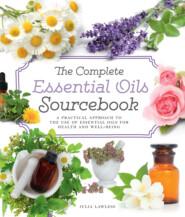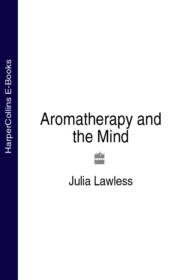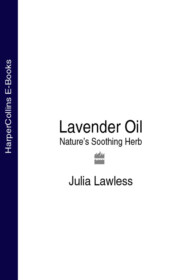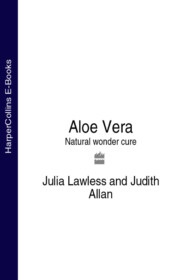По всем вопросам обращайтесь на: info@litportal.ru
(©) 2003-2024.
✖
Rosemary Oil: A new guide to the most invigorating rememdy
Настройки чтения
Размер шрифта
Высота строк
Поля
Rosemary Oil: A new guide to the most invigorating rememdy
Julia Lawless
Rosemary has been cultivated since ancient times, once playing a central role in many traditional rites and ceremonies. It has been valued for its medical, culinary and cosmetic properties for thousands of years.This traditional ‘cure all’ folk remedy is also one of the most popular essential oils. Rosemary oil is principally used to invigorate and stimulate the body, and provides a good counterbalance to calming oils, such as lavender. In this new guide, Julia Lawless explains why the oil is so versatile and how to use it therapeutically.Employed for a variety of purposes from liver tonic to the treatment of muscular aches and pains, rosemary is beneficial for many other common health conditions including:• Rheumatism• Arthritis• Headaches• Sinusitis• Low blood pressure• Hair loss• Dandruff
Copyright (#ulink_33bbbab8-21d3-5e96-a3a8-5ec4a7726d06)
Thorsons
An Imprint of HarperCollinsPublishers
77–85 Fulham Palace Road,
Hammersmith, London W6 8JB
First published by Thorsons 1996
© Julia Lawless 1996
A catalogue record for this book is available from the British Library
Julia Lawless asserts the moral right to be identified as the author of this work
All rights reserved under International and Pan-American Copyright Conventions. By payment of the required fees, you have been granted the nonexclusive, nontransferable right to access and read the text of this e–book on–screen. No part of this text may be reproduced, transmitted, downloaded, decompiled, reverse–engineered, or stored in or introduced into any information storage and retrieval system, in any form or by any means, whether electronic or mechanical, now known or hereafter invented, without the express written permission of HarperCollins e–books.
HarperCollinsPublishers has made every reasonable effort to ensure that any picture content and written content in this ebook has been included or removed in accordance with the contractual and technological constraints in operation at the time of publication.
Source ISBN 9780722533499
Ebook Edition © AUGUST 2014 ISBN: 9780008108434
Version: 2014-08-26
Dedication (#ulink_604e1ace-0e18-528f-b3b9-5979ee63b2fb)
To Judy
Contents
Cover (#u1a978be8-f8cb-5d39-a53b-553351dfd932)
Title Page (#u43a3228a-6df6-5c80-8fc5-5416d88b9691)
Copyright (#ulink_ecb53d83-dea7-5772-ba37-c770d6813ebb)
Dedication (#ulink_313ba073-0ec7-5924-ab2b-b3a641aedf23)
Rosemary Oil – An Introduction (#ulink_e45545c7-72d8-542e-aec8-b1a2793dc508)
Part I: A Medical and Historical Background
1 The Herb of Remembrance (#ulink_288ea6f9-31d4-5570-a414-dcfc4f832974)
2 A Traditional ‘Cure All’ Folk Remedy (#ulink_b5c57510-737d-5c0b-a33c-16bcb31bec4c)
3 Rosemary Oil: Chemical Analysis and Clinical Research (#ulink_d83b4653-7f2b-5125-986e-1dd53e9a0370)
4 Cultivation, Production and Quality Control (#litres_trial_promo)
5 A Summary of the Properties and Applications of Rosemary Oil (#litres_trial_promo)
6 Methods of Use, Safety Data and Storage Precautions (#litres_trial_promo)
Part II: A–Z of Health and Beauty Applications: (#litres_trial_promo)
amenorrhoea (absent/irregular periods); (#litres_trial_promo)arteriosclerosis; (#litres_trial_promo)arthritis; (#litres_trial_promo)asthma; (#litres_trial_promo)boil (furuncle)/abscess; (#litres_trial_promo)bronchitis; (#litres_trial_promo)bursitis; (#litres_trial_promo)carbuncles; (#litres_trial_promo)cellulite; (#litres_trial_promo)chilblains; (#litres_trial_promo)colds; (#litres_trial_promo)colitis; (#litres_trial_promo)constipation; (#litres_trial_promo)coughs; (#litres_trial_promo)dandruff; (#litres_trial_promo)debility (nervous); (#litres_trial_promo)depression; (#litres_trial_promo)disinfectant; (#litres_trial_promo)dysmenorrhoea (period pain); (#litres_trial_promo)dyspepsia (indigestion) and flatulence; (#litres_trial_promo)faintness/dizziness; (#litres_trial_promo)fever; (#litres_trial_promo)flu; (#litres_trial_promo)gout; (#litres_trial_promo)hair care; (#litres_trial_promo)hangover; (#litres_trial_promo)headaches; (#litres_trial_promo)immune system (to strengthen); (#litres_trial_promo)insect repellent; (#litres_trial_promo)jetlag; (#litres_trial_promo)laryngitis; (#litres_trial_promo)liver problems/congestion; (#litres_trial_promo)low blood-pressure (hypotension); (#litres_trial_promo)lumbago; (#litres_trial_promo)migraine; (#litres_trial_promo)mouth and gum infections; (#litres_trial_promo)muscular aches and pains; (#litres_trial_promo)neuralgia; (#litres_trial_promo)oedema (fluid retention); (#litres_trial_promo)palpitations (tachycardia); (#litres_trial_promo)perfume; (#litres_trial_promo)perspiration (excessive); (#litres_trial_promo)pets/animal care; (#litres_trial_promo)rheumatism; (#litres_trial_promo)sciatica; (#litres_trial_promo)sinusitis; (#litres_trial_promo)skin care; (#litres_trial_promo)sore throat; (#litres_trial_promo)sprains; (#litres_trial_promo)stress; (#litres_trial_promo)varicose veins; (#litres_trial_promo)whooping cough (#litres_trial_promo)
Keep Reading (#litres_trial_promo)
Appendix A: Recipes Using Rosemary (#litres_trial_promo)
Appendix B: The Constituents of Rosemary Oil (#litres_trial_promo)
Bibliography and Further Reading (#litres_trial_promo)
References (#litres_trial_promo)
Useful Addresses (#litres_trial_promo)
Acknowledgements (#litres_trial_promo)
Other Books By (#litres_trial_promo)
About the Publisher (#litres_trial_promo)
Rosemary Oil: An Introduction (#ulink_25eefa27-3e22-57af-9dc4-24cf25392d8d)
Rosemarie, the chiefest beauties of Gardens and not to be wanted in the Kitchen.
B. Googe, Four Books of Husbandry (1577)
Rosemary has been called the ‘Prince’ of aromatic herbs – and it is not difficult to understand why! This handsome evergreen shrub with narrow, dark green leaves and small blue or mauve flowers has been cultivated since ancient times and is still a familiar sight in many gardens today. The flowers and ‘needles’ are endowed with the most delightful, refreshing scent, and rosemary has always been valued as one of the most important culinary herbs, having a strong, distinctive flavour. It has also been highly esteemed for its medicinal and cosmetic properties for thousands of years, and once played a central role in many traditional rites and ceremonies.
Rosemary belongs to the large botanical family Labiatae (Lamiaceae) along with lavender and many of the other common aromatic herbs, including marjoram, sage, thyme and mint. The native habitat of the wild rosemary (Rosmarinus officinalis) is Asia Minor and southern Europe; like lavender, it thrives in the Mediterranean region. It can still be found growing in profusion along the Mediterranean coastline, on the Balkan Peninsula, throughout Spain and Portugal and, to a lesser extent, in Turkey, Egypt and the Lebanon. It is one of the few shrubs that can survive the rigorous climate of the Sahara desert, although it is more at home growing in proximity to water. Indeed, its name is derived from the Latin ros (dew) and marinus (sea), meaning ‘Dew of the Sea’.
Rosemary has probably been cultivated in Great Britain for over 600 years, having been introduced by the Romans. Some sources say that it then went out of cultivation until the fourteenth century, when it was re-introduced by Queen Philippa, wife of King Edward III. Today it can be found growing in gardens throughout the world, even as far north as Canada, Scandinavia and Russia. In more northerly climes, however, it rarely grows taller than 1.2 m (4 ft) high, whereas in its natural habitat Rosmarinus officinalis can reach 1.8 m (6 ft) or more in height. It is also slightly frost-tender and needs the protection of a cold frame or the shelter of a south- or west-facing wall to survive a cold winter. Neither will rosemary tolerate water-logged conditions, and is best grown in well-drained limey soil or in a pot containing lots of broken crockery to ensure good drainage.
Rosemary is a favourite with gardeners and is often grown purely as a decorative plant both for its scent and for its fine stature. Gertrude Jekyll writes in her book House and Garden ‘… ever-blessed rosemary all over the garden, so that at every few steps the passer-by can run his hand over the blue-flowered branchlets and smell the warm resinous incense in his palm.’
Sir Thomas More let it run all over his garden walls because, he wrote, ‘My bees love it.’ Other men have apparently been more cautious about letting it grow too freely! There is an old folk belief that says ‘where rosemary flourishes, the woman rules’:
Julia Lawless
Rosemary has been cultivated since ancient times, once playing a central role in many traditional rites and ceremonies. It has been valued for its medical, culinary and cosmetic properties for thousands of years.This traditional ‘cure all’ folk remedy is also one of the most popular essential oils. Rosemary oil is principally used to invigorate and stimulate the body, and provides a good counterbalance to calming oils, such as lavender. In this new guide, Julia Lawless explains why the oil is so versatile and how to use it therapeutically.Employed for a variety of purposes from liver tonic to the treatment of muscular aches and pains, rosemary is beneficial for many other common health conditions including:• Rheumatism• Arthritis• Headaches• Sinusitis• Low blood pressure• Hair loss• Dandruff
Copyright (#ulink_33bbbab8-21d3-5e96-a3a8-5ec4a7726d06)
Thorsons
An Imprint of HarperCollinsPublishers
77–85 Fulham Palace Road,
Hammersmith, London W6 8JB
First published by Thorsons 1996
© Julia Lawless 1996
A catalogue record for this book is available from the British Library
Julia Lawless asserts the moral right to be identified as the author of this work
All rights reserved under International and Pan-American Copyright Conventions. By payment of the required fees, you have been granted the nonexclusive, nontransferable right to access and read the text of this e–book on–screen. No part of this text may be reproduced, transmitted, downloaded, decompiled, reverse–engineered, or stored in or introduced into any information storage and retrieval system, in any form or by any means, whether electronic or mechanical, now known or hereafter invented, without the express written permission of HarperCollins e–books.
HarperCollinsPublishers has made every reasonable effort to ensure that any picture content and written content in this ebook has been included or removed in accordance with the contractual and technological constraints in operation at the time of publication.
Source ISBN 9780722533499
Ebook Edition © AUGUST 2014 ISBN: 9780008108434
Version: 2014-08-26
Dedication (#ulink_604e1ace-0e18-528f-b3b9-5979ee63b2fb)
To Judy
Contents
Cover (#u1a978be8-f8cb-5d39-a53b-553351dfd932)
Title Page (#u43a3228a-6df6-5c80-8fc5-5416d88b9691)
Copyright (#ulink_ecb53d83-dea7-5772-ba37-c770d6813ebb)
Dedication (#ulink_313ba073-0ec7-5924-ab2b-b3a641aedf23)
Rosemary Oil – An Introduction (#ulink_e45545c7-72d8-542e-aec8-b1a2793dc508)
Part I: A Medical and Historical Background
1 The Herb of Remembrance (#ulink_288ea6f9-31d4-5570-a414-dcfc4f832974)
2 A Traditional ‘Cure All’ Folk Remedy (#ulink_b5c57510-737d-5c0b-a33c-16bcb31bec4c)
3 Rosemary Oil: Chemical Analysis and Clinical Research (#ulink_d83b4653-7f2b-5125-986e-1dd53e9a0370)
4 Cultivation, Production and Quality Control (#litres_trial_promo)
5 A Summary of the Properties and Applications of Rosemary Oil (#litres_trial_promo)
6 Methods of Use, Safety Data and Storage Precautions (#litres_trial_promo)
Part II: A–Z of Health and Beauty Applications: (#litres_trial_promo)
amenorrhoea (absent/irregular periods); (#litres_trial_promo)arteriosclerosis; (#litres_trial_promo)arthritis; (#litres_trial_promo)asthma; (#litres_trial_promo)boil (furuncle)/abscess; (#litres_trial_promo)bronchitis; (#litres_trial_promo)bursitis; (#litres_trial_promo)carbuncles; (#litres_trial_promo)cellulite; (#litres_trial_promo)chilblains; (#litres_trial_promo)colds; (#litres_trial_promo)colitis; (#litres_trial_promo)constipation; (#litres_trial_promo)coughs; (#litres_trial_promo)dandruff; (#litres_trial_promo)debility (nervous); (#litres_trial_promo)depression; (#litres_trial_promo)disinfectant; (#litres_trial_promo)dysmenorrhoea (period pain); (#litres_trial_promo)dyspepsia (indigestion) and flatulence; (#litres_trial_promo)faintness/dizziness; (#litres_trial_promo)fever; (#litres_trial_promo)flu; (#litres_trial_promo)gout; (#litres_trial_promo)hair care; (#litres_trial_promo)hangover; (#litres_trial_promo)headaches; (#litres_trial_promo)immune system (to strengthen); (#litres_trial_promo)insect repellent; (#litres_trial_promo)jetlag; (#litres_trial_promo)laryngitis; (#litres_trial_promo)liver problems/congestion; (#litres_trial_promo)low blood-pressure (hypotension); (#litres_trial_promo)lumbago; (#litres_trial_promo)migraine; (#litres_trial_promo)mouth and gum infections; (#litres_trial_promo)muscular aches and pains; (#litres_trial_promo)neuralgia; (#litres_trial_promo)oedema (fluid retention); (#litres_trial_promo)palpitations (tachycardia); (#litres_trial_promo)perfume; (#litres_trial_promo)perspiration (excessive); (#litres_trial_promo)pets/animal care; (#litres_trial_promo)rheumatism; (#litres_trial_promo)sciatica; (#litres_trial_promo)sinusitis; (#litres_trial_promo)skin care; (#litres_trial_promo)sore throat; (#litres_trial_promo)sprains; (#litres_trial_promo)stress; (#litres_trial_promo)varicose veins; (#litres_trial_promo)whooping cough (#litres_trial_promo)
Keep Reading (#litres_trial_promo)
Appendix A: Recipes Using Rosemary (#litres_trial_promo)
Appendix B: The Constituents of Rosemary Oil (#litres_trial_promo)
Bibliography and Further Reading (#litres_trial_promo)
References (#litres_trial_promo)
Useful Addresses (#litres_trial_promo)
Acknowledgements (#litres_trial_promo)
Other Books By (#litres_trial_promo)
About the Publisher (#litres_trial_promo)
Rosemary Oil: An Introduction (#ulink_25eefa27-3e22-57af-9dc4-24cf25392d8d)
Rosemarie, the chiefest beauties of Gardens and not to be wanted in the Kitchen.
B. Googe, Four Books of Husbandry (1577)
Rosemary has been called the ‘Prince’ of aromatic herbs – and it is not difficult to understand why! This handsome evergreen shrub with narrow, dark green leaves and small blue or mauve flowers has been cultivated since ancient times and is still a familiar sight in many gardens today. The flowers and ‘needles’ are endowed with the most delightful, refreshing scent, and rosemary has always been valued as one of the most important culinary herbs, having a strong, distinctive flavour. It has also been highly esteemed for its medicinal and cosmetic properties for thousands of years, and once played a central role in many traditional rites and ceremonies.
Rosemary belongs to the large botanical family Labiatae (Lamiaceae) along with lavender and many of the other common aromatic herbs, including marjoram, sage, thyme and mint. The native habitat of the wild rosemary (Rosmarinus officinalis) is Asia Minor and southern Europe; like lavender, it thrives in the Mediterranean region. It can still be found growing in profusion along the Mediterranean coastline, on the Balkan Peninsula, throughout Spain and Portugal and, to a lesser extent, in Turkey, Egypt and the Lebanon. It is one of the few shrubs that can survive the rigorous climate of the Sahara desert, although it is more at home growing in proximity to water. Indeed, its name is derived from the Latin ros (dew) and marinus (sea), meaning ‘Dew of the Sea’.
Rosemary has probably been cultivated in Great Britain for over 600 years, having been introduced by the Romans. Some sources say that it then went out of cultivation until the fourteenth century, when it was re-introduced by Queen Philippa, wife of King Edward III. Today it can be found growing in gardens throughout the world, even as far north as Canada, Scandinavia and Russia. In more northerly climes, however, it rarely grows taller than 1.2 m (4 ft) high, whereas in its natural habitat Rosmarinus officinalis can reach 1.8 m (6 ft) or more in height. It is also slightly frost-tender and needs the protection of a cold frame or the shelter of a south- or west-facing wall to survive a cold winter. Neither will rosemary tolerate water-logged conditions, and is best grown in well-drained limey soil or in a pot containing lots of broken crockery to ensure good drainage.
Rosemary is a favourite with gardeners and is often grown purely as a decorative plant both for its scent and for its fine stature. Gertrude Jekyll writes in her book House and Garden ‘… ever-blessed rosemary all over the garden, so that at every few steps the passer-by can run his hand over the blue-flowered branchlets and smell the warm resinous incense in his palm.’
Sir Thomas More let it run all over his garden walls because, he wrote, ‘My bees love it.’ Other men have apparently been more cautious about letting it grow too freely! There is an old folk belief that says ‘where rosemary flourishes, the woman rules’:





